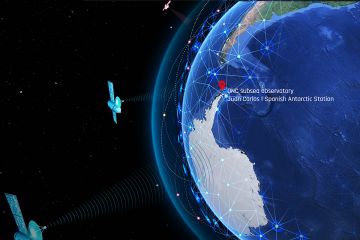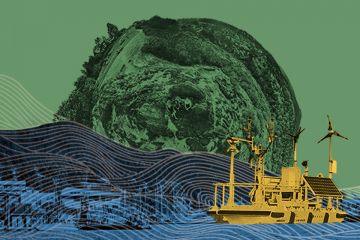Catalyst for energy transition
- Anne Tolson

A vision to ensure that Canadian policymakers can make the best decisions when setting out to remove carbon from the country’s energy systems is a big step closer to reality with the creation of a national energy modelling centre.
On May 25, Natural Resources Canada announced $5 million toward the new Energy Modelling Hub (EMH), which will be led by a team of researchers at University of Victoria, Polytechnique Montréal and the University of Calgary.
UVic civil engineer Madeleine McPherson’s vision and research have been a driving force behind the creation of the hub. The new entity aims to provide consistent, evidenced-based tools and information to policymakers on how best to transition from fossil fuels to cleaner energy sources, such as wind and solar.
“Policymakers are looking for pathways to transform Canada’s energy systems to meet climate goals,” says McPherson. “We need modelling to see into the future to show us how to make the best decisions to remove carbon from our energy systems. Then we need to get that information into the hands of the decision-makers who can turn net zero into a reality.”
The work conducted by McPherson and contributing to the new hub reflects UVic’s commitment to climate action, as articulated in the United Nations Sustainable Development Goals.
Bridging the gap
The energy modelling landscape in Canada is fractured and the hub hopes to link the modelling community and decision-makers. Energy modelling is a process of using computers to simulate various parts of energy systems, which are too vast and complex to replicate in a lab. These models help researchers understand the ramifications of various large-scale “what if” scenarios, and serve as crucial tools in making effective decisions about decarbonization, or the broad, systemic reduction of carbon.
“We’re trying to make predictions 20 or 50 years into the future and we’re trying to understand complex things like how our building energy infrastructure will impact climate and vice versa,” McPherson explains. “Energy models are tools that allow us to ask those exploratory questions before we make massive investments in new systems that will last for decades and cost us billions of dollars.”
UVic’s Institute for Energy Systems (IESVic) will lead the technical side of the new hub, continuing to develop and refine energy models and other tools initiated a few years ago under McPherson’s direction. Polytechnique Montréal will serve as the administrative centre where the hub will be headquartered, organizing workshops and coordinating outreach. The University of Calgary will bring economics and policy expertise to the group.
A vision takes shape
McPherson first got the idea for a Canadian energy modelling hub when she was working as a postdoctoral researcher at the National Renewable Energy Laboratory (NREL) in Colorado — the primary centre for energy research and development in the US, which works closely with American law makers.
“When I worked at the NREL, I witnessed a very effective vehicle for translating energy modelling work into decision-making,” says McPherson, who is originally from Salt Spring Island a Southern Gulf Island between Victoria and mainland BC. “It occurred to me that we really don’t really have a similar kind of institution in Canada and that just seemed like a really big gap.”
While a lot of great energy modelling work is being done in Canada, there is no central institution to leverage this expertise to its full potential. McPherson was convinced that Canada needed its own central hub — with energy models and data that reflected Canada’s social, political and historical realities, such as Indigenous community ownership, for example.
McPherson returned to Canada determined to fill the gap and found a perfect fit at IESVic. IESVic researchers focus on the deep decarbonization of energy systems, ranging from buildings and transportation, to power systems and geographical regions of every size.
“I think it’s safe to say that IESVic is the powerhouse for energy systems modelling in Canada,” she says.

Laying the foundation
Since arriving at UVic in 2018, McPherson has built up a team of more than 20 graduate students and researchers, who have worked with her to develop three key software platforms: a database of energy system information; a growing repository of energy system models that span sectors, scales and vectors; and a visualization platform, which produces graphs and other visual aids to quickly communicate results.
When contacted by an eligible organization, McPherson works with that stakeholder to explore possible energy scenarios, using this software capacity.
“The number of organizations that have reached out over the last few years for modelling work has been overwhelming,” she says. “It is important work that I really believe must get done, but there is just too much volume for our team to handle on our own — this work needs to be institutionalized.”
Examples of organizations that have reached out include: the David Suzuki Foundation, the City of Regina, The Transition Accelerator charity and several research labs.
Determining which energy model (or models) to use depends on what the organization is trying to accomplish. For example, The Transitions Accelerator — a charity devoted to net-zero emissions by 2050 — requested a study on how integrating the power systems of the four western provinces could help decarbonize the region as a whole. In another case, the David Suzuki Foundation wanted to explore different pathways to get to net-zero electricity in Canada by 2035.
Going forward, the three software platforms developed at UVic will form the technical foundation of the new national hub. McPherson will be hiring five engineers and researchers to further develop these platforms and work with stakeholder organizations.
Advancing climate action
The new EMH builds on the work of an earlier initiative, which was also funded by Natural Resources Canada. From 2019 to 2021, that group (with a similar name of the Energy Modelling Initiative) gathered data, held workshops and forums, and built an inventory of the different modelling groups in Canada and the types of models they use. One of the key recommendations of the earlier initiative was to create an institution like the new EMH.
The three researchers who led that earlier initiative are now part of the four-person executive committee leading the new hub: McPherson at UVic, Normand Mousseau and Louis Beaumier both of Polytechnique Montréal. More recently, Blake Shaffer, of the University of Calgary, has joined the executive committee.
Ultimately, McPherson’s team will begin transferring the technology platforms developed at UVic to the central EMH for maintenance and development over the long term. It’s expected the hub will eventually become self-sustaining by transitioning to a service model.
The work done by McPherson’s group — and the EMH — is open source, meaning that their energy models, other tools and training materials will be available to anyone working in the area.
“I’m delighted for other researchers and energy modellers to use our models, data and visualizations, and for other organizations to benefit from them,” she says. “The more of this work in decarbonization that we can do, the better for everyone, and the better for the planet.”
Read the Government of Canada news release here.
Photos
In this story
Keywords: sustainable impact, climate action, sustainability, clean energy, climate, computers, research, technology
People: Madeleine McPherson





